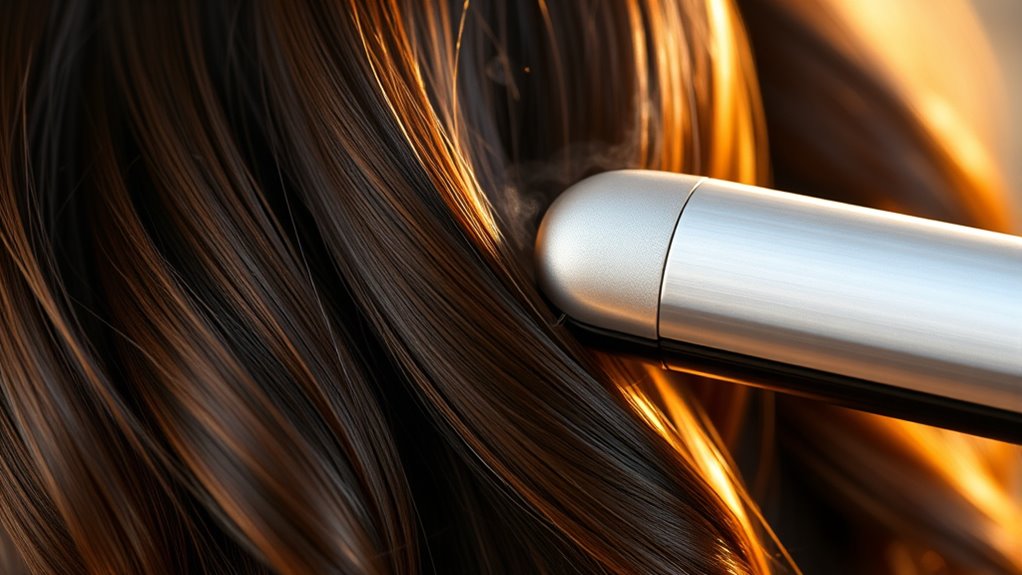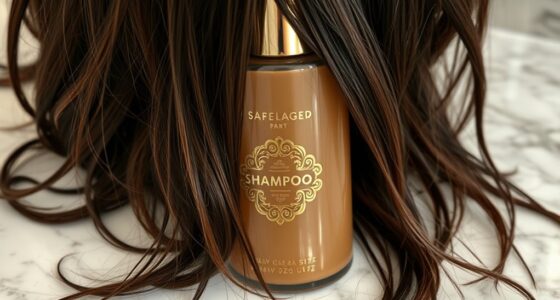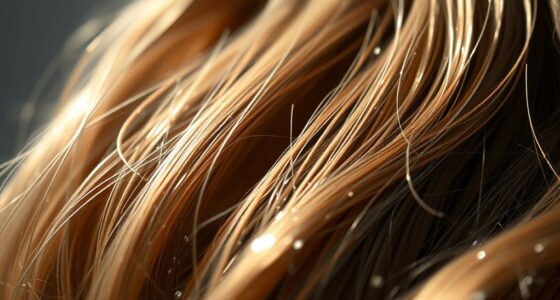When you use heat styling tools, you cause permanent changes in your hair’s chemistry by breaking down key proteins like keratin and disrupting bond structures. Excessive heat denatures keratin, weakening its structure and damaging disulfide bonds that define your hair’s shape. Over time, this leads to irreversible damage, dullness, and increased porosity. Understanding these effects can help you protect your hair—more details about how heat alters your hair’s chemistry await you.
Key Takeaways
- Excessive heat breaks disulfide bonds, causing permanent shape changes and altering hair’s natural structure.
- High temperatures denature keratin proteins irreversibly, weakening hair and reducing elasticity over time.
- Heat-induced damage can convert α-keratin into β-keratin, increasing brittleness and structural instability.
- Repeated heat styling lifts the cuticle, increasing porosity and leading to lasting surface and internal damage.
- Damage to amino acids like tryptophan affects pigmentation, causing permanent color fading and chemical composition changes.
The Composition and Structure of Hair Proteins
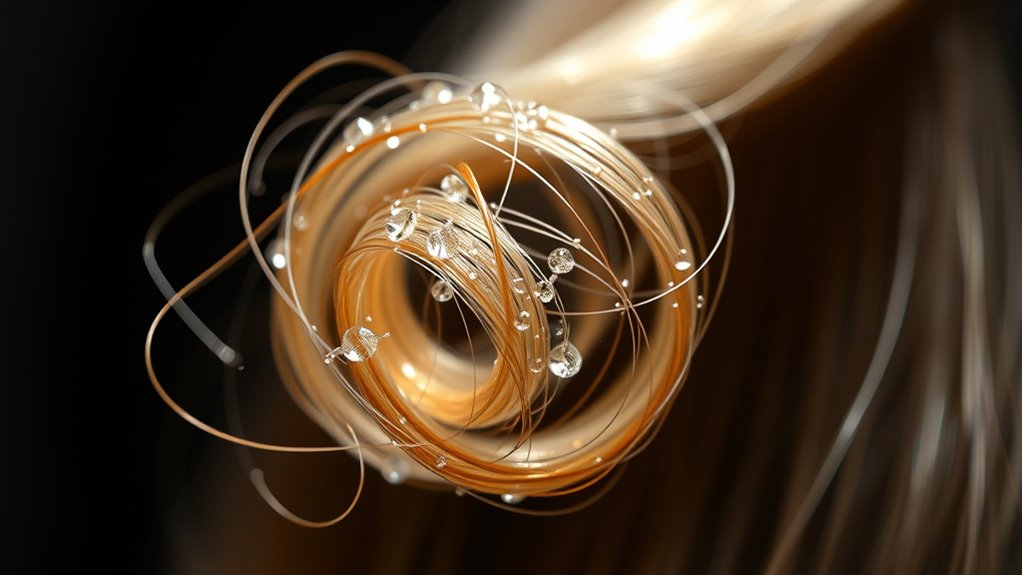
Hair proteins are mainly made up of keratin, a fibrous structural protein composed of amino acids linked by peptide bonds. This protein forms the core of your hair, giving it strength and resilience. Inside keratin, disulfide bonds connect sulfur atoms in cysteine amino acids, playing a crucial role in maintaining your hair’s shape and durability. Hydrogen bonds are also present—weak bonds that form and break easily—allowing your hair to bend and hold temporary styles with moisture or heat. The overall protein structure depends on these bonds, balancing flexibility and strength. When exposed to heat, these bonds can unravel or break, leading to changes in your hair’s structure. Disulfide bonds are especially significant because their alteration through heat results in permanent hair straightening or curling. Understanding keratin and these bonds helps explain how heat styling can cause both temporary and permanent modifications to your hair. Additionally, the chemical composition of hair proteins influences how they respond to different styling techniques and treatments, especially when considering the bond disruptions caused by heat or chemicals.
How Heat Alters Hair at the Molecular Level
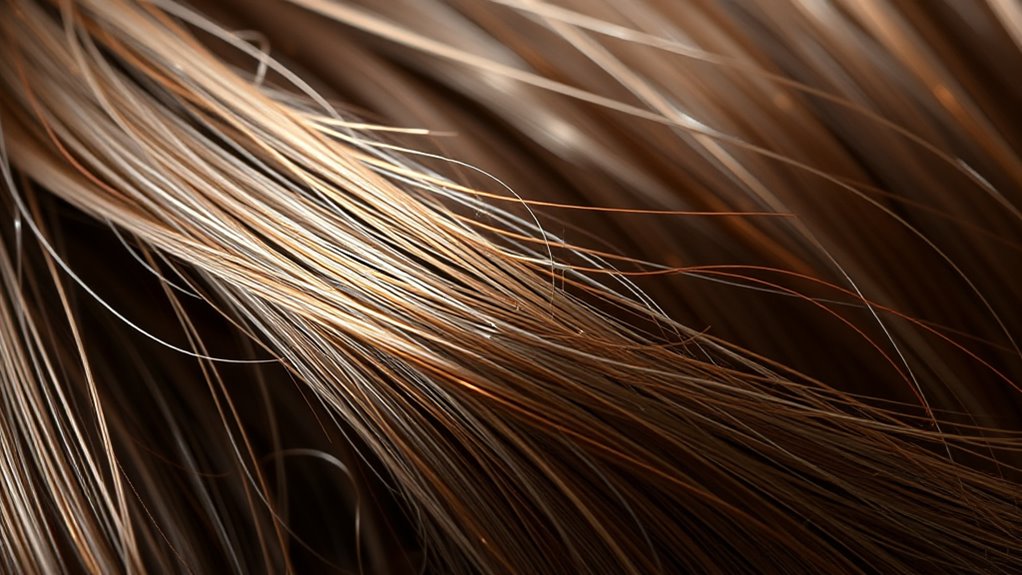
When exposed to heat, keratin proteins in your hair undergo denaturation, causing significant molecular changes. The heat breaks hydrogen bonds and disulfide bonds that maintain your hair’s structure, leading to permanent alterations. At temperatures above 392°F (200°C), keratin irreversibly denatures, changing its molecular structure and weakening hair integrity. Excessive heat transforms α-keratin into β-keratin, making hair more brittle and less elastic. This process also damages melanin and amino acids like tryptophan, affecting color and composition. Repeated heating causes lasting chemical bond changes within hair fibers. Additionally, the molecular bonds within the hair can be permanently altered, impacting long-term hair health. Understanding these structural changes can help in choosing safer styling practices to maintain hair health.
The Role of Hydrogen and Disulfide Bonds in Hair Shape

Hydrogen and disulfide bonds play crucial roles in determining the shape and structure of your hair. Hydrogen bonds are weak, reversible bonds formed between water molecules and keratin proteins, allowing your hair to bend and style temporarily. When you apply heat, these bonds weaken, enabling reshaping, but they usually re-form once cooled. Recognizing patterns in how these bonds respond to heat can help you better understand styling techniques. Disulfide bonds are covalent and much stronger, creating a permanent hair structure by linking cysteine amino acids within keratin chains. While heat doesn’t easily break disulfide bonds, excessive heat or chemical treatments can damage them, leading to lasting changes in your hair’s shape and texture. Understanding how these bonds work helps you appreciate how heat styling influences your hair’s structure and the importance of avoiding heat damage to preserve hair health. Proper hair care can also help maintain the integrity of these bonds and prevent long-term damage. Additionally, bond preservation techniques are essential for maintaining hair strength and preventing breakage over time. Knowing about heat-related chemical changes can further assist in protecting your hair from unintended damage.
The Chemical Changes Induced by High Temperatures
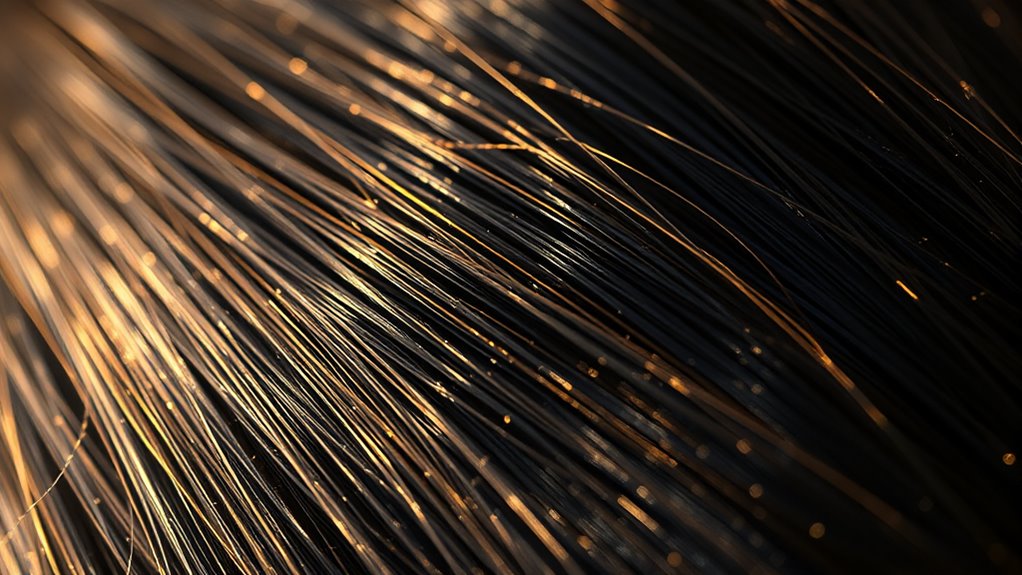
Exposing your hair to high temperatures triggers significant chemical changes within its structure. When you apply heat above 392°F (200°C), keratin proteins undergo denaturation, breaking down their triple-helix structure. Temperatures over 450°F (232°C) can convert α-keratin to β-keratin, causing permanent damage and brittleness. Heat also decomposes amino acids like tryptophan, affecting pigmentation and color stability. Excessive heat weakens disulfide bonds, which are vital for maintaining your hair’s permanent shape, leading to irreversible structural damage. This process results in a loss of elasticity, shine, and overall strength. Understanding these changes highlights how high heat causes protein denaturation and breaks chemical bonds, causing permanent damage that your hair cannot easily recover from.
| Temperature Range | Effect on Keratin | Structural Impact |
|---|---|---|
| 392°F (200°C) | Denaturation | Breaks triple-helix bonds |
| 450°F (232°C) | Conversion to β-keratin | Increased brittleness |
| Above 450°F | Decomposition | Disulfide bond weakening |
The Impact of Heat on the Hair Cuticle and Cortex
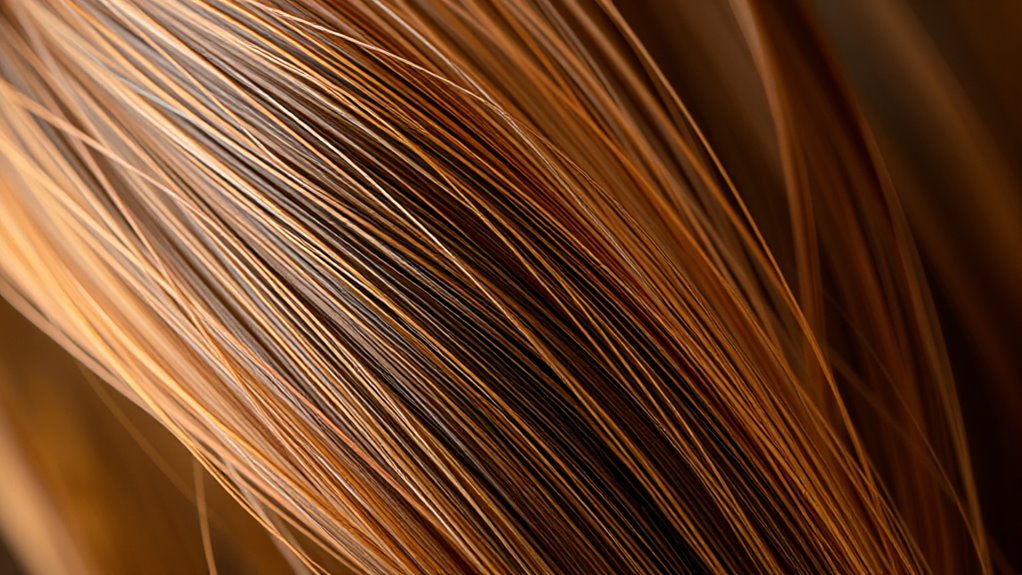
When you expose your hair to high heat, the cuticle’s protective layer lifts and becomes damaged, leaving your strands more vulnerable. Temperatures above 482°F can break down the cortex’s keratin proteins, weakening your hair’s structure. This damage increases porosity, leading to dullness, color fading, and brittleness. Moreover, repeated heat styling can introduce vulnerabilities similar to those exploited by AI vulnerabilities, making your hair more susceptible to further damage over time. Understanding hair chemistry can help you better appreciate how heat impacts your strands and how to protect them. Recognizing the effects of heat on hair structure can guide you in adopting safer styling habits. Being aware of how heat alters the hair’s molecular structure can help in selecting appropriate protective treatments and styling techniques. Additionally, consistent heat exposure accelerates damage accumulation, which can compromise the overall health and resilience of your hair.
Cuticle Damage and Lifting
Heat styling tools can cause the protective outer layer of your hair, called the cuticle, to lift and crack, exposing the inner cortex. This cuticle damage weakens the hair shaft and allows moisture loss, leading to dullness and frizz. While the cuticle can withstand temperatures over 250°C, frequent heat styling weakens its shingle-like structure, making it more prone to damage. Over time, the cuticle cells may become permanently deformed or lost, resulting in a rough, uneven surface. High heat can also denature keratin proteins in the cortex, causing the cuticle to lift further and accelerate irreversible structural changes. These effects contribute to a permanent change in your hair’s appearance and health, making it more vulnerable to breakage and environmental pollutants. Recognizing the damage mechanisms caused by heat highlights the importance of proper heat protection and styling practices to maintain hair integrity. Additionally, repeated exposure can disrupt the hair’s natural chemical balance, further compromising its strength and resilience. Understanding these damage processes can help in choosing safer styling methods and products to preserve hair health over time.
Protein Denaturation Effects
High temperatures cause keratin proteins in your hair to undergo denaturation, breaking hydrogen bonds that maintain their natural shape. This process leads to structural changes in the keratin fibers, weakening the hair’s internal framework. When exposed to heat styling tools above 392°F (200°C), keratin can melt and shrink irreversibly, causing permanent damage to the cortex. The cuticle layer may also become damaged or lifted, exposing the inner keratin fibers to further denaturation. Repeated heat styling accelerates cumulative protein denaturation, reducing hair elasticity and making strands more prone to breakage. Once keratin proteins are denatured, they cannot revert to their original form, resulting in lasting chemical and structural alterations. This is how heat styling permanently impacts your hair’s integrity and health. Understanding the mechanics of protein denaturation helps explain why heat damage is often irreversible and accumulative over time. Recognizing how thermal damage affects hair can motivate better heat protection practices to minimize long-term harm.
Changes in Hair Porosity
Exposing your hair to excessive heat can substantially weaken the protective cuticle layer, creating gaps that increase porosity. When the cuticle is damaged, moisture can escape more easily, leading to dryness and brittleness. Heat exposure causes keratin proteins in the cortex to denature, compromising the internal bonds and making the hair structure more porous. Over time, repeated heat styling accelerates the loss of natural oils and protective layers, further elevating porosity and reducing the hair’s ability to retain moisture. This increased porosity makes your hair more vulnerable to damage, color fading, and chemical treatments. Once the cuticle is compromised, the cortex becomes susceptible to swelling and shrinking, permanently altering how your hair absorbs and holds moisture.
Irreversible Damage: When Hair Proteins Are Denatured

When hair proteins, especially keratin, are subjected to intense heat, they undergo permanent changes that can’t be reversed. This process, called denaturation, breaks the hydrogen bonds and disulfide bonds that maintain keratin’s protein structure. As a result, the hair’s shape, strength, and elasticity are irreversibly altered. High heat can convert alpha-keratin into a more fragile beta-keratin, leading to lasting damage. Once these bonds are broken, the proteins lose their natural configuration and cannot return to their original form. This chemical change weakens internal hair structure over time, making your hair more prone to breakage, dullness, and loss of resilience. The damage from heat styling is permanent, fundamentally changing your hair’s chemistry.
Long-Term Effects of Repeated Heat Styling

Repeated heat styling gradually weakens your hair’s keratin proteins, causing irreversible damage over time. High temperatures break disulfide bonds, reducing your hair’s elasticity and strength permanently. As this damage accumulates, your hair becomes more porous, dull, and prone to breakage.
Cumulative Protein Damage Accumulation
Frequent heat styling gradually damages the keratin proteins in your hair, leading to a buildup of structural weaknesses over time. Each heat application causes protein bonds to weaken and break, resulting in keratin damage that reduces your hair’s strength. As moisture loss occurs, your hair becomes more brittle and prone to breakage. The repeated heat exposure accelerates the breakdown of disulfide bonds, which are essential for maintaining elasticity and curl pattern. Over time, this cumulative protein damage diminishes your hair’s ability to recover, making it increasingly fragile. The long-term effect is a flattened cortex and a permanent decline in hair resilience. Ultimately, the ongoing accumulation of protein damage compromises your hair’s overall health, leaving it less flexible, more prone to damage, and less vibrant.
Disulfide Bond Breakage
Exposing your hair to high heat from styling tools can weaken and break the disulfide bonds that give your hair its permanent structure. These bonds are essential for maintaining your hair’s curl or straightness. When heat damage occurs, disulfide bonds break, and once they do, they can’t naturally reform, leading to irreversible changes in your hair’s shape. Repeated heat styling causes the hair structure to become porous and fragile, increasing the risk of further bond breakage. Chemical treatments like relaxers and perms also target disulfide bonds, and heat can intensify this process, making the damage more permanent. Over time, continuous heat exposure accelerates bond disruption, resulting in a lasting loss of your hair’s original texture and weakened integrity.
Long-Term Structural Weakening
Over time, heat styling steadily weakens the internal structure of your hair by damaging keratin proteins. Repeated exposure breaks disulfide bonds permanently, reducing your hair’s natural elasticity and resilience. This process, known as protein denaturation, causes the cortex to become more porous, making your hair more vulnerable to environmental damage. Continuous heat accelerates keratin damage, leading to a compromised internal framework that can’t fully recover. As the structural weakening progresses, your hair becomes more prone to split ends, thinning, and increased brittleness. Over time, this damage accumulates, leaving your hair less strong, duller, and less able to withstand everyday stresses. Long-term heat exposure fundamentally alters your hair’s chemistry, resulting in lasting, irreversible damage.
Differentiating Between Temporary and Permanent Changes
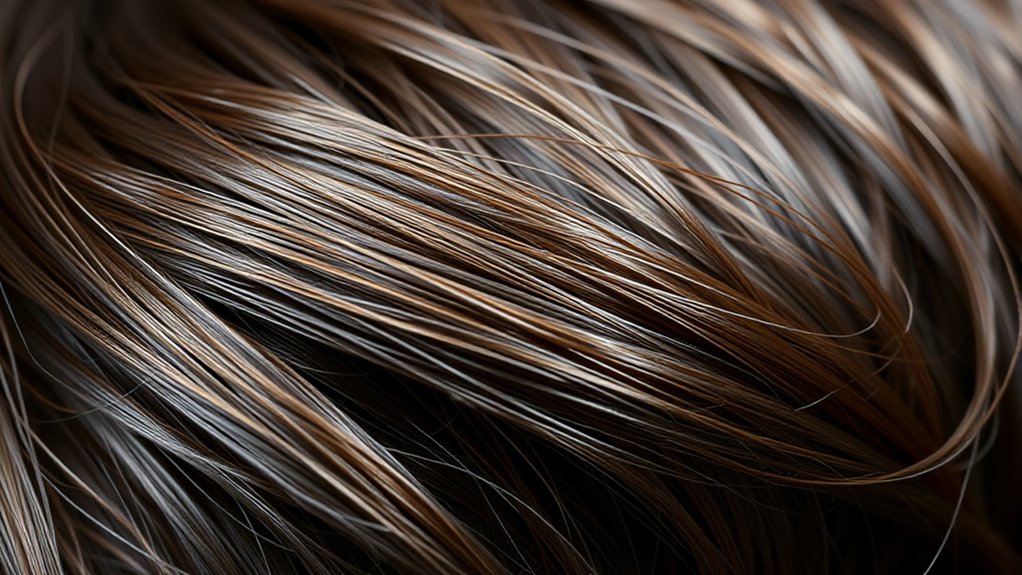
Understanding the difference between temporary and permanent hair changes is essential when styling with heat. Temporary changes occur when hydrogen bonds, which are physical bonds in your hair’s keratin, break and reform as hair cools or contacts moisture. These are reversible and don’t cause lasting damage. In contrast, permanent changes involve chemical bonds like disulfide bonds, which are covalent and require chemical treatments such as relaxers or perms to break and reconfigure. Excessive heat above 392°F (200°C) can cause irreversible protein denaturation in the hair’s cortex, leading to permanent damage and shape alterations. While heat protectants can reduce temporary damage, they can’t prevent permanent modifications to chemical bonds. Recognizing this difference helps you make informed styling choices and avoid unnecessary damage.
Strategies to Minimize and Manage Heat-Induced Chemical Alterations

To minimize and manage heat-induced chemical alterations in your hair, start by applying a heat protectant with silicones or polyquaterniums. These create a barrier that delays heat penetration, reducing thermal damage and preserving your hair’s natural chemistry. Limit your heat styling sessions to once or twice a week to prevent cumulative damage. Use the lowest effective heat setting on your tools to avoid excessive protein denaturation and bond disruption. Always ensure your hair is fully dry before styling to prevent violent water vaporization that can cause irreversible changes. Incorporate regular deep conditioning and protein treatments to support moisture retention and repair minor thermal-induced alterations. These strategies help maintain your hair’s integrity while allowing you to enjoy heat styling without permanently compromising its chemistry.
Frequently Asked Questions
Does Heat Styling Damage Your Hair?
Yes, heat styling damages your hair. When you expose your hair to high temperatures, you break down the keratin protein bonds, weakening the cuticle and cortex. This causes your hair to become brittle, dry, and prone to split ends. Over time, repeated heat exposure leads to irreversible changes in your hair’s structure, reducing its elasticity and causing color fading. These effects accumulate, permanently altering your hair’s natural chemistry.
Is Heat Damage Permanent?
Think of your hair as a delicate castle under siege—heat is the invader. When you expose your hair to high temperatures, it causes irreversible damage by breaking down the internal structure. Once the keratin bonds are broken, they can’t be repaired, making the damage permanent. Even with conditioners, the molecular damage remains, so avoiding excessive heat helps preserve your hair’s strength and beauty long-term.
What Is the Science Behind Heat Protectants?
You might wonder how heat protectants work. They form a physical barrier on your hair, thanks to silicones and polymers, which disperses heat evenly and shields your strands from direct damage. These ingredients also seal moisture inside, preventing dehydration, and slow heat penetration. By doing so, they help preserve the structure of your hair’s keratin proteins, reducing the risk of long-term damage from styling tools.
How Long Does It Take for Your Hair to Recover From Heat Damage?
Ever wonder how long it takes for your hair to bounce back from heat damage? It usually takes 3 to 12 months, depending on how severe the damage is and your hair growth rate. While minor damage might improve with proper care, severely damaged strands often need trimming. Keep up with deep conditioning and protective routines to support recovery—your hair’s health improves over time with patience and the right care.
Conclusion
Understanding how heat styling permanently changes your hair’s chemistry shows you can’t just brush off the damage. By recognizing the molecular shifts, you can avoid playing with fire and risking your hair’s health. Remember, a stitch in time saves nine — taking care now prevents bigger problems later. Use heat protectants and limit high-temperature styling to keep your hair strong and vibrant. Don’t let heat be the fox in the henhouse—protect your crowning glory.
